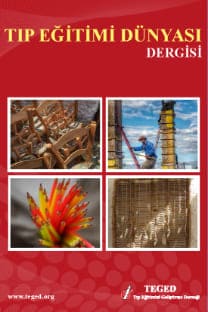Tıp Fakültesi Son Sınıf Öğrencilerinin Umutsuzluk Düzeylerinin Belirlenmesi
medical student, hopelessnes, hopelessnes scala
Determination of Hopelessness Levels of Final Year Students of The Faculty of Medicine
Medical student, hopelessness, hopelessness scale,
___
- 1- Beck AT, Steer RA, Kovacs M, Gamion B. Hopelessness and eventual suicide: a 10 year prospective study of patients hospitalized with suicidal intention. Am J Psychiatry 1985; 142: 559-563.
- 2-Vatan S, Lester D, Gunn JF. Emotion Dysregulation, Problem-Solving, and Hopelessness. Psychol Rep. 2014; 114 (2): 647-51
- 3-Greene SM. The relationship between depression and hopelessness. Implications for current theories of depression. Br J Psychiatry 1989; 154: 650–659
- 4-Tanaka E, Sakamoto S, Ono Y, Fujihara S, Kitamura T. Hopelessness in a community population in Japan. J Clin Psychol 1996; 52: 609–615.
- 5- Edwards MJ, Holden RR. Coping, meaning in life, and suicidal manifestations: examining gender differences. J Clin Psychol 2001; 57: 1517–1534.
- 6- Girgin G. Evaluation of the factors affecting loneliness and hopelessness among university students in Turkey. Social Behavior and Personality 2009; 37: 811-818.
- 7- Zeyrek EY, Gencoz F, Bergman Y, Lester D. Suicidality, problem-solving skills, attachment style, and hopelessness in Turkish students. Death Studies 2009; 33: 815-827.
- 8- Ergin A, Bozkurt AI, Uzun SU. Level of Hopelessness and Related Factors in Upcoming Medical Work Force. JME 2016; 15 (1): 15-22.
- 9-Budakoglu Iİ, Karaoğlu N, Coskun Ö. Loneliness, Hopelessness, Anxiety And Self Compassion Of Medical Students: Gazi Example. GMJ. 2014; 25: 165-170
- 10-Baiden P, Mengo C, Boateng GO, Small E. Investigating the association between age at first alcohol use and suicidal ideation among high school students: Evidence from the youth risk behavior surveillance system. J. Affect Disord. 2019; 1 (242): 60-67
- 11- Torres AR, Campos LM, Lima MCP, Ramos-Cerqueira ATA. Suicidal Ideation Among Medical Students Prevalence and Predictors. J Nerv Ment Dis 2018; 206: 160-168
- 12- Brazeau CM, Shanafelt T, Durning SJ, Massie FS, Eacker A, Moutier C et al. Distress among matriculating medical students relative to the general population. Acad Med. 2014; 89 (11): 1520-1525.
- 13- Enns MW, Cox BJ, Sareen J, Freeman P. Adaptive and maladaptive perfectionism in medical students: a longitudinal investigation. Med Educ. 2001; 35: 1034-42.
- 14- Report of the Ad Hoc Committee of Deans. Educating doctors to provide high quality medical care. A vision for medical education in the United States. Washington, DC: AAMC; 2004.
- 15-Geurts S, Rutte C, Peeters M. Antecedents and consequences of work-home interference among medical residents. Soc Sci Med. 1999; 48: 1135-48.
- 16-Beck AT, Weissman A, Lester D, Trexler L. The measurement of pessimism: The hopelessness scale. J Consult Clin Psychol. 1974; 42: 861-65.
- 17- Durham TW. Norms, reliability and item analysis of the hopelessness scale in general psyhiatric, forensic psychiatric, and college population. J Clin Psychology 1982; 38: 597-600
- 18- Cochrane-Brink KA, Lofchy JS, Sakinofsky I. Gen Hosp Psychiatry 2000; 22 (6): 445-51
- 19-Seber G, Dilbaz N, Kaptanoglu C, Tekin D. Hopelessness Scale: Validity and Reliability. Crisis Journal (Kriz Dergisi) 1993; 1: 139-42.
- 20-Willcock Sm, Daly Mg, Tennant Cc, Allard Bj. Burnout And Psychiatric Morbidity In New Medical Graduates. Med J 2004; 181 (7): 357-60
- 21- Hayat AA, Salehi A, Kojuri J. Medical student’s academic performance: The role of academic emotions and motivation. J Adv Med Educ 2018; 6 (4): 168-175
- 22-Pompili M, Lester D, Innamorat M, Narciso V, Vento A, De Pisa et al. Risk-taking and reasons for living in non-clinical Italian university students. Death Stud. 2007; 31 (8): 751-62.
- 23-Karaoglu N, Coskun Ö, Budakoglu II. Meram Medical Faculty Students' Levels of Loneliness, Hopelessness And Anxiety Against Their Self Understanding. Tıp Eğitimi Dünyası 2017; 48: 49-61.
- 24- Güler M, Demirci K, Karakuş K, Kişioglu AN, Zengin E, Yozgat Z et al. Determination of the Relationship Between Hopelessness-Depression Frequency and Sociodemographic Characteristics in Suleyman Demirel University Medical Faculty Students. Int J Basic Clin Med 2014; 2 (1): 32-37.
- 25-Wilson CJ, Deane FP. Help-Negation and Suicidal Ideation: The Role of Depression, Anxiety and Hopelessness. J Youth Adolesc. 2010; 39 (3): 291-305
- 26- Cam Çelikel F, Erkorkmaz Ü. Factors associated with Depressive Symptoms and Hopelessness Levels in University Students. Arch Neuropsychiatry 2008; 45: 122-9.
- 27-Lester D. Hopelessness in undergraduate students around the world: A review. J Affect Disord. 2013; 150: 1204-1208.
- 28-Viñas Poch F, Villar E, Caparros B, Juan J, Cornella M, Perez I. Feelings of hopelessness in a Spanish university population - decriptive analysis and its relationship to adapting to university, depressive symptomatology and suicidal ideation. Soc Psychiatry Psychiatr Epidemiol. 2004; 39 (4): 326-34.
- 29- Erözkan A . Investigation of Factors Predicting the Anxiety Level of University Senior Students. IOJES 2011; 3 (2), 776-805
- 30-Aish AM, Wasserman D, Renberg ES. Does Beck's Hopelessness Scale really measure several components? Psychol Med 2001;31(2):367-72.
- ISSN: 1303-328X
- Yayın Aralığı: 3
- Başlangıç: 2000
- Yayıncı: Tıp Eğitimini Geliştirme Derneği
Tıp Fakültesi Son Sınıf Öğrencilerinin Umutsuzluk Düzeylerinin Belirlenmesi
Türkkan ÖZTÜRK KAYGUSUZ, Ahmet ERENSOY
Öğretim Tasarımı, Modelleri ve Program Geliştirmeyle İlişkisi
Yavuz Selim KIYAK, İrem BUDAKOĞLU, Özlem COŞKUN
Funda TAYFUN KÜPESİZ, Neslihan ANDIC, Melike SEZGİN EVİM, İbrahim EKER, Fergun AYDİN, Gülen TÜYSÜZ, Dilek GÜRLEK, Melek ISIK, Yesim OYMAK, Berna ATESAGAOGLU, Tugba BELGEMEN, İsil ERDOGAN, Utku AYGÜNEŞ, Gül İLHAN, Ersin TÖRET, Ayse AKİNCİ, Ozlem TUFEKCİ, Burcak TATLİ, Begum SİRİN, Başak ÜNVER KOLUMAN, Süheyla OCAK, Musta
Sema OZAN, Özlem MİMAN, Cemal H GÜVERCİN, Zehra DEMİROĞLU UYANIKER
Sinem İNANICI, Galip YARDIMCI, Yeliz R. BİNATAMİR, Rozerin Göze YÜKSEL
Yeşim GÜROL, Oğuz Can IŞIK, Levent ALTINTAŞ, Melike ŞAHİNER
İskelet Sistemi Anatomisi Eğitiminde Takıma Dayalı Öğrenme Yönteminin Uygulanması
Pelin İSMAİLOĞLU, Fatma KAHRAMAN, Mustafa AKTEKİN, Melike ŞAHİNER, Levent ALTINTAŞ
Tıp Fakültesi Dönem 1-2-3 Öğrencilerinin İletişim ve Empati Becerilerinin Analizi
Seyhan DEMİR KARABULUT, Hatice Yağmur ZENGİN, Rifat Vedat YILDIRIM, Zerrin YILMAZ ÇELİK
